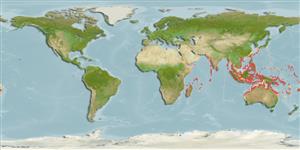Teleostei (teleosts) >
Pleuronectiformes (Flatfishes) >
Bothidae (Lefteye flounders)
Etymology: Asterorhombus: Greek, aster = star + Greek, rhombos = paralelogram (Ref. 45335); cocosensis: Named for its type locality, Cocos Island (Ref. 57759).
More on author: Bleeker.
Environment: milieu / climate zone / depth range / distribution range
Ecology
Marine; demersal; depth range 1 - 30 m (Ref. 57759). Tropical
Indo-West Pacific: Mozambique to Fiji; north to Japan, south to Queensland, Australia (not occurring nonmarginally on the Pacific Plate).
Size / Weight / Age
Maturity: Lm ? range ? - ? cm
Max length : 12.0 cm SL male/unsexed; (Ref. 57759)
Dorsal soft rays (total): 79 - 83; Anal soft rays: 59 - 64; Vertebrae: 35 - 36. This species is characterized by the following: body depth 51.5-58.3; sexual dimorphism
in interorbital width, in specimens approximately 6.0 cm SL, males 4.1-7.9, females 3.2-5.0; first dorsal-fin ray isometric relative to SL, with distinct membranous structure confined to tip. Pectoral fin count at the ocular side 10-13, blind side 8-11. The membranous structure at the tip of the first dorsal fin resembles a small fish or crustacean (possibly a small hippolytid shrimp), authors called the ray the illicium and the structure at the tip as the esca (Ref. 57759).
Found on pale sandy substrates in clearwater coastal bays to outer reef lagoons and sandy gutters on reef flats. Often crawls over low stony reef (Ref. 48637). The membranous structure at the tip of the first dorsal fin resembles a small fish or crustacean (possibly a small hippolytid shrimp), authors called the ray the illicium and the structure at the tip as the esca. The illicium waves the esca back and forth near mouth to attract prey. Shows sexual dimorphism in width of the interorbital origin, wider in males than females. Most frequently collected by divers.
Life cycle and mating behavior
Maturities | Reproduction | Spawnings | Egg(s) | Fecundities | Larvae
Hensley, D.A., 2005. Revision of the genus Asterorhombus (Pleuronectiformes: Bothidae). Copeia 2005(3):445-460. (Ref. 57759)
IUCN Red List Status (Ref. 130435)
Threat to humans
Harmless
Human uses
Tools
Special reports
Download XML
Internet sources
Estimates based on models
Preferred temperature (Ref.
123201): 24.8 - 29.3, mean 28.4 °C (based on 3223 cells).
Phylogenetic diversity index (Ref.
82804): PD
50 = 0.6250 [Uniqueness, from 0.5 = low to 2.0 = high].
Bayesian length-weight: a=0.00912 (0.00408 - 0.02036), b=3.05 (2.87 - 3.23), in cm total length, based on LWR estimates for this (Sub)family-body shape (Ref.
93245).
Trophic level (Ref.
69278): 3.6 ±0.59 se; based on food items.
Resilience (Ref.
120179): Medium, minimum population doubling time 1.4 - 4.4 years (Preliminary K or Fecundity.).
Fishing Vulnerability (Ref.
59153): Low vulnerability (10 of 100).
